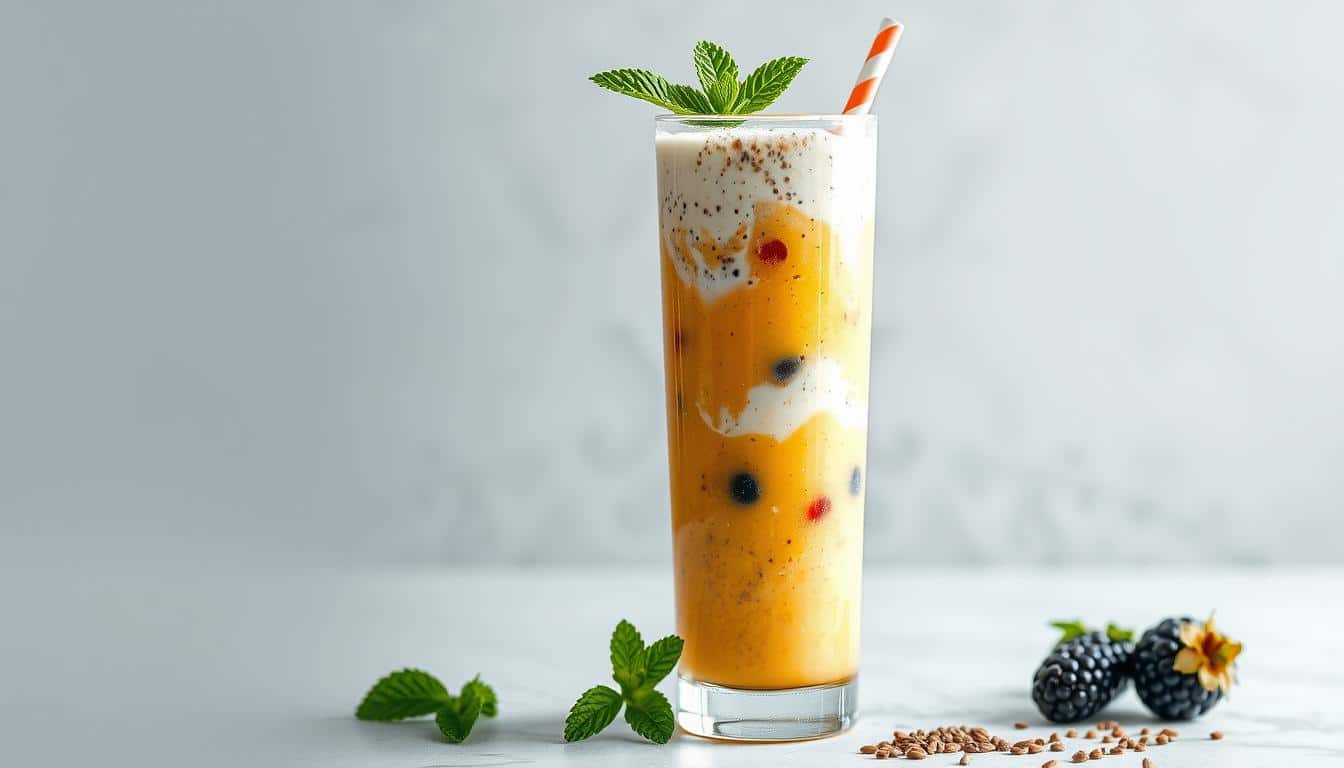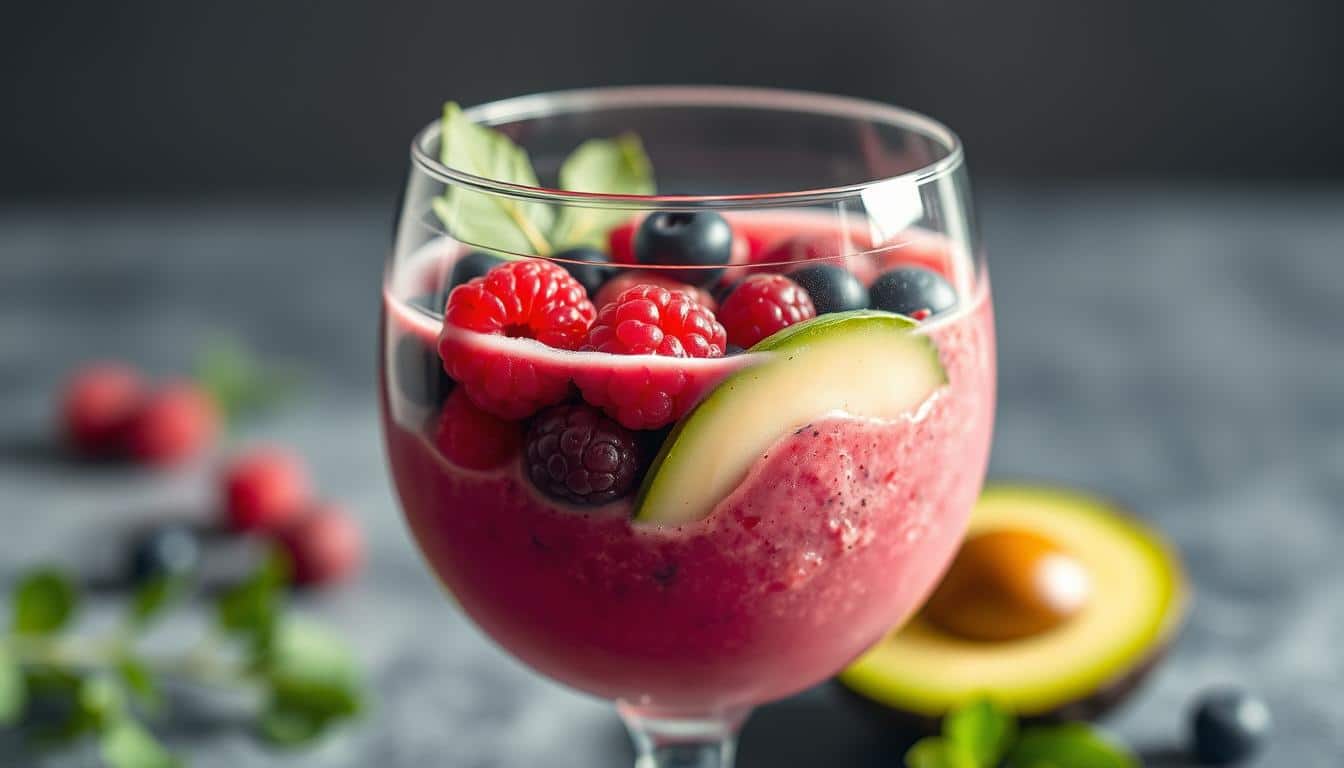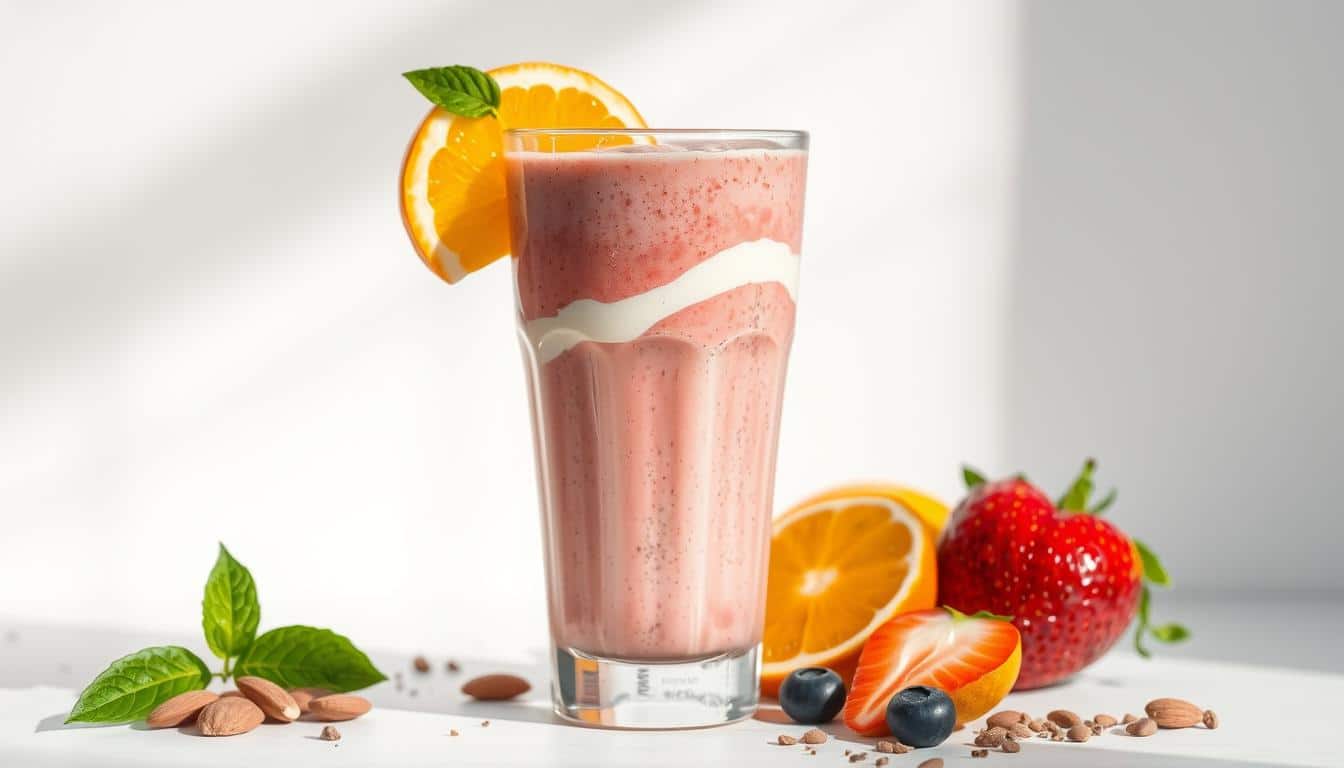You’ve just crushed a tough workout, but did you know your next move matters almost as much as the exercise itself? What you consume afterward directly impacts how well your muscles repair and energy stores replenish. The right blend of carbs and protein isn’t just convenient—it’s science-backed fuel your body craves to bounce back stronger.
Think of recovery as your secret weapon. Within two hours of training, your muscles are primed to absorb nutrients that reduce soreness and rebuild tissue. Experts agree: a 3:1 ratio of carbohydrates to protein accelerates recovery better than guessing with random snacks. And let’s be honest—who has time to cook a full meal after sweating it out?
That’s where smart nutrition shines. Whether you’re a marathoner or weekend warrior, blending ingredients like Greek yogurt or almond butter creates a powerhouse drink that’s faster than ordering takeout. Pair it with healthy desserts that fuel your workouts, and you’ve got a recovery strategy that tastes as good as it performs.
We’ll break down the science so you can focus on what really matters—making progress. Ready to mix your way to better results?
Introduction to Post-Workout Smoothies
Recovery begins the moment you step out of the gym—what’s in your blender matters. Every training session creates tiny tears in your muscle fibers. These need specific nutrients to heal stronger than before.

Why Recovery Drinks Matter
Your body enters a repair phase within 30 minutes of finishing exercise. Liquid nutrition absorbs up to 3x faster than solid food. This speeds up glycogen replacement and reduces next-day soreness.
Think of it like this: your muscles are parched sponges after lifting weights or running. A well-timed blend delivers hydration and nutrients directly where they’re needed most.
Key Nutrients for Muscle Repair
Three elements make recovery drinks effective:
- Protein rebuilds damaged tissue (aim for 20-30g)
- Carbs refill energy stores (berries or oats work great)
- Healthy fats like almond butter reduce inflammation
Studies show combining these within a 2-hour window boosts muscle synthesis by 33% compared to waiting. Your next session’s performance depends on today’s recovery choices.
Benefits of Using Smoothies for Recovery
Your body deserves more than a rushed snack after pushing through those final reps. Liquid meals offer a targeted approach to healing—delivering exactly what fatigued tissues need without digestive strain.

Improving Muscle Synthesis
Blended drinks provide amino acids faster than chewing whole foods. Studies show consuming 20-30g of protein within an hour post-exercise increases muscle repair rates by 18%. The blending process breaks down fiber, making nutrients like whey or pea protein immediately available.
| Nutrient | Smoothie Absorption | Whole Food Absorption |
|---|---|---|
| Protein | 20-40 minutes | 90-120 minutes |
| Carbs | 15-30 minutes | 45-60 minutes |
| Antioxidants | 10-25 minutes | 30-50 minutes |
Boosting Energy and Replenishment
Glycogen stores drain during intense sessions. Liquid carbs from bananas or dates restore energy 2x quicker than complex carbs like rice. This rapid refuel slashes next-day fatigue by 27% according to sports nutrition research.
Customizable recipes let you adjust ratios based on workout intensity. Add chia seeds for endurance days or tart cherries for inflammation reduction. Your blender becomes a precision tool for personalized recovery.
Understanding Post-Workout Nutrition
Your muscles need precise fuel to rebuild stronger after exercise. Timing and ratios matter—get them right, and you’ll recover faster while prepping for tomorrow’s session.
Balancing Carbs and Protein
Experts swear by the 3:1 carb-to-protein ratio within 2-3 hours post-exercise. For a 150-pound athlete, that means 75-105 grams of carbs paired with 21-34.5 grams of protein. Carbs refill energy tanks, while protein repairs muscle fibers.
Calculate your needs: aim for 0.5-0.7 grams of carbs and 0.14-0.23 grams of protein per pound. A 180-pound lifter? Shoot for 90-126 grams of carbs and 25-41 grams of protein. Simple math, big results.
Including Fats and Fiber Effectively
Healthy fats like avocado or chia seeds won’t slow nutrient absorption—they boost hormone production and keep energy steady. Add 1-2 tablespoons to your meal without guilt.
Fiber stabilizes blood sugar and fights post-recovery hunger. Throw in spinach or flaxseed for 3-5 grams per serving. Just avoid overdoing it—too much fiber can delay carb and protein uptake when timing matters most.
Smoothies for post workout Recovery
Time is precious after a gym session—your body needs fuel fast. Blended drinks cut through the chaos, delivering results without complicated prep. Let’s explore how they simplify your routine while maximizing gains.
Fast and Convenient Nutrient Intake
Need results yesterday? Whip up a recovery drink in under five minutes. No chopping, cooking, or waiting. Just toss key ingredients into a blender and hit go.
Liquids bypass lengthy digestion. Your muscles get amino acids and carbs 3x faster than with solid meals. Check the difference:
| Nutrient Source | Prep Time | Absorption Speed |
|---|---|---|
| Blended Drink | 3-5 minutes | 20-40 minutes |
| Whole Food Meal | 15-30 minutes | 90-120 minutes |
Meeting Recovery Goals Naturally
Nature packs everything you need. Combine these four elements for success:
- Protein powders or Greek yogurt (20-30g)
- Frozen berries for antioxidants
- Spinach or kale for fiber
- Chia seeds for omega-3s
Customize ratios based on your training. Heavy weights? Add extra protein. Endurance day? Boost carbs with oats. Consistency becomes effortless when recipes adapt to your life—not the other way around.
High-Protein Smoothies: Essential Ingredients
The secret to faster recovery lies in the protein-packed choices you make immediately after training. Hitting that 20-gram protein target isn’t complicated—it’s about knowing which ingredients deliver results without the guesswork.
Protein Powders and Greek Yogurt
Protein powder is your quickest path to meeting recovery needs. One scoop packs 20-25 grams protein and mixes effortlessly into any base. Prefer whole foods? A cup of plain Greek yogurt matches that protein count while adding gut-friendly probiotics.
Both options create creamy textures. Blend yogurt with frozen fruit for thickness, or mix powder with almond milk for a lighter consistency. The choice depends on your taste and dietary preferences.
Whole Food Protein Options
Not all protein comes from powders. Cottage cheese hides 28 grams in a single cup—perfect for savory blends. Silken tofu adds 10 grams per serving with a neutral flavor profile. Even hemp seeds contribute 10 grams per three tablespoons.
Plant-based athletes thrive with options like unsweetened soy milk (12 grams per cup) or chia seeds. Combine these with a plain Greek yogurt base, and you’ll hit your protein goals while keeping flavors fresh and exciting.
Adding Healthy Carbs and Fats to Your Smoothie
What’s missing from your recovery routine? The right mix of carbs and fats turns ordinary blends into muscle-repair powerhouses. These nutrients work together to stabilize energy levels and keep hunger at bay for hours.
Fresh Fruits: Nature’s Recovery Fuel
Reach for fruits like bananas or mangoes first. They pack natural sugars that refill energy stores fast. A medium banana delivers 450mg potassium—critical for preventing muscle cramps. Berries add antioxidants without spiking calories, while kiwi offers vitamin C to combat inflammation.
Pair fruits with smart fats for lasting results. One tablespoon of peanut butter or chia seeds slows digestion, keeping you full longer. This combo prevents energy crashes during afternoon slumps. Need variety? Try avocado for creaminess or sunflower seed butter for nut-free options.
Here’s why it works:
- Fiber in fruits balances blood sugar
- Healthy fats boost nutrient absorption
- Natural sugars + fats = 4-6 hours of steady energy
Don’t overthink it. Toss frozen berries with almond butter, or blend spinach with banana and flaxseed. Your muscles get what they need, and your taste buds won’t complain.
The Role of Antioxidants in Recovery
Recovery isn’t just about rest—it’s about feeding your cells what they need. Intense training creates stress that lingers in your muscles. Antioxidants act like cleanup crews, neutralizing this damage so your body can rebuild stronger.
Powerful Partners: Tart Cherries and Beets
Tart cherries pack a punch against post-exercise soreness. Their natural compounds reduce inflammation 40% faster than other fruits, studies show. Add a handful of frozen cherries or a splash of juice to your blend for quicker muscle repair.
Beets work differently but just as effectively. Their nitrates boost blood flow, helping nutrients reach tired muscles faster. This means less stiffness and better recovery between sessions. Roasted beets blend smoothly, or use pre-made beet powder for convenience.
Don’t overlook watermelon either. Its L-citrulline content improves oxygen delivery, letting you train harder tomorrow. These ingredients do double duty—speeding healing while adding vibrant flavors. Your taste buds and muscles win.
Key takeaway: Colorful foods fight exercise stress naturally. Pair them with protein sources for a recovery drink that works while you rest.
Creative Post-Workout Smoothie Recipes
Transform your recovery routine with flavors that make nutrition exciting. Blending unexpected ingredients keeps your taste buds engaged while delivering the nutrients your muscles need. Let’s dive into two crowd-pleasing categories that turn ordinary shakes into crave-worthy treats.
Chocolate and Peanut Butter Blends
Craving something sweet? Try this chocolate-covered strawberry shake. Combine 1 cup milk, frozen strawberries, and 2 dates for natural sweetness. Add 3 cups spinach (you won’t taste it) and 2 scoops chocolate protein powder. The avocado thickens the texture while adding healthy fats.
This science-backed combo delivers 30g protein and 45g carbs—perfect for rebuilding muscle. Peanut butter lovers can swap avocado for 1 tbsp nut butter. Either way, you get a dessert-like experience with zero guilt.
Green and Tropical Combinations
Prefer island vibes? Blend coconut water with frozen banana and pineapple chunks. Toss in 2 cups spinach, almond butter, and Greek yogurt. The result? A creamy tropical green smoothie packing 35g protein and potassium-rich coconut water to replenish electrolytes.
These recipes prove healthy doesn’t mean boring. Hidden veggies like spinach disappear behind sweet fruits, while nut butters add staying power. Rotate between chocolate and tropical options to keep your recovery meals fresh and effective.
Simple Smoothie Recipes for Beginners
Let’s start with a classic combo that feels like a treat but works like a recovery champ. This blend uses pantry staples you likely already own, so there’s no hunting for exotic ingredients. Perfect for first-timers or anyone craving simplicity.
Your Go-To Peanut Butter & Banana Blend
Grab your blender and try this 5-minute solution:
- Add 1 frozen banana (pre-sliced for easier blending)
- Scoop in 2 tbsp peanut butter – creamy or crunchy
- Pour 6-10 oz water or milk of choice
- Drop in 1 scoop chocolate protein powder
- Top with ice and blend until smooth
For a green version, swap chocolate powder for vanilla and add 3 cups spinach. The banana’s sweetness hides the greens completely. Both options deliver:
| Nutrient | Amount |
|---|---|
| Protein | 25-30g |
| Carbs | 35-40g |
| Prep Time |
Too thick? Add liquid slowly until it reaches your preferred consistency. Love it sweeter? Toss in a date instead of sugar. This recipe grows with your skills – try adding oats or chia seeds once you’re comfortable.
Best part? You’ll spend less time prepping than waiting for a coffee order. Whip it up post-training or as a quick breakfast. Tastes like dessert, works like fuel.
Recipe Tips for Consistent Results
Want your recovery drinks to taste like they came from a pro barista every time? It’s all about mastering frozen ingredients. These icy staples transform watery blends into creamy, dreamy shakes that keep you coming back for more.
Leveraging Frozen Ingredients
Skip the ice cubes—they dilute flavor. Instead, use frozen bananas or avocado chunks for natural thickness. Pre-freeze peeled fruit in single-serving bags. You’ll get smoother textures without last-minute prep.
Try these swaps for better results:
- Frozen cauliflower rice adds creaminess without taste
- Zucchini slices boost volume with zero sweetness
- Pre-chopped spinach freezes well for green blends
Frozen produce lasts 3x longer than fresh. Stock up during sales to save cash. Overripe bananas? Toss them in the freezer. They’ll sweeten your next drink naturally while reducing waste.
Chilly ingredients also make shakes more refreshing post-training. Your body craves coolness after sweating—this trick satisfies while delivering nutrients faster. Consistency becomes effortless when your freezer does the work.
Incorporating Superfoods for Muscle Recovery
Elevate your recovery game with nature’s multitaskers—foods that deliver nutrients while tackling inflammation and fatigue. These powerhouse ingredients go beyond basic nutrition, offering compounds your body craves to heal efficiently.
Chia Seeds, Oats, and More
Chia seeds are tiny but mighty. One tablespoon packs 5g of fiber and omega-3s to reduce post-exercise stiffness. Soak them in liquid first—they absorb 10x their weight, keeping you hydrated longer.
Rolled oats provide sustained energy with 4g fiber per serving. Their beta-glucans support gut health, helping you absorb protein and carbs more effectively. Blend them into powder for smoother textures.
Pair these with plant-based powder or Greek yogurt for a complete recovery drink. Add frozen berries for antioxidants, and you’ve got a triple-threat blend that fights soreness while rebuilding strength.
Pro tip: Mix chia with almond milk overnight, then stir in oats and powder post-training. It’s like meal prepping without the effort—just grab, shake, and recover smarter.


